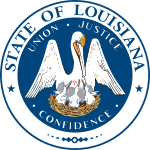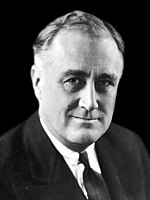| ||||||||||||||||||||||||||
All 10 Louisiana votes to the Electoral College | ||||||||||||||||||||||||||
|---|---|---|---|---|---|---|---|---|---|---|---|---|---|---|---|---|---|---|---|---|---|---|---|---|---|---|
| ||||||||||||||||||||||||||
 Parish Results
| ||||||||||||||||||||||||||
| ||||||||||||||||||||||||||
| Elections in Louisiana |
|---|
 |
|
|
The 1936 United States presidential election in Louisiana took place on November 3, 1936, as part of the 1936 United States presidential election. Louisiana voters chose ten[2] representatives, or electors, to the Electoral College, who voted for president and vice president.
Ever since the passage of a new constitution in 1898, Louisiana had been a one-party state dominated by the Democratic Party. The Republican Party became moribund due to the disenfranchisement of blacks and the complete absence of other support bases as Louisiana completely lacked upland or German refugee whites opposed to secession.[3] Despite this absolute single-party dominance, non-partisan tendencies remained strong among wealthy sugar planters in Acadiana and within the business elite of New Orleans.[4]
Until the rise of Huey P. Long, post-disenfranchisement Louisiana politics was dominated by the New Orleans–based “Choctaw Club”,[5] which overcame Socialist, Wobbly, and Progressive challenges from the outlying upcountry, Imperial Calcasieu and Acadiana regions between the late 1900s and early 1920s.[6] The three presidential elections between 1916 and 1924 saw a rebellion in Acadiana over sugar tariffs and Woodrow Wilson’s foreign and domestic policies; however, the nomination of Catholic Al Smith in 1928 rapidly restored their Democratic loyalty without causing significant upheaval in the remainder of the state, which was too focused on control of black labour to worry about Smith’s Catholicism.[7]
Following the 1928 gubernatorial primary, Louisiana politics until Brown v. Board of Education would be governed by a system of coherent “Long” and “anti-Long” Democratic factionalism,[8] as the administration of Huey Long introduced significant economic reforms, which were strongly opposed by the remnants of the old Choctaws. During the first term of Roosevelt, Long sought to capture the Presidency for himself under a “Share-Our-Wealth” program involving the confiscation of wealthy fortunes, family allowances, and government storage of agricultural surpluses.[9] However, in the ensuing years Long’s fortunes dwindled as a result of 1934 losses in the Sixth Congressional District and the New Orleans city council,[10] before Senator Long launched a siege on New Orleans and the Choctaws, combined with abolition of the state’s poll tax, in effort to regain his control over the state.[11]
However, Long’s assassination in 1935 meant he could not launch any presidential campaign. Although the sugar parishes did oppose incumbent President Franklin D. Roosevelt’s tariff policy strongly,[7] with the result that frequently rebellious Assumption and Lafourche Parishes showed a strong swing to Republican nominees Governor Alf Landon and veteran Illinois operative Frank Knox, Louisiana was won by Roosevelt and Vice President John Nance Garner, with 88.82 percent of the popular vote, against Landon’s 11.16 percent.[12][13] By percentage of the popular vote won, Louisiana was Roosevelt's third-best state, behind only South Carolina (98.57 percent) and Mississippi (97.06 percent).
- ^ "United States Presidential election of 1936 — Encyclopædia Britannica". Retrieved January 15, 2019.
- ^ "1936 Election for the Thirty-eighth Term (1937-41)". Retrieved January 15, 2019.
- ^ Phillips, Kevin P. (November 23, 2014). The Emerging Republican Majority. Princeton University Press. pp. 208, 210. ISBN 9780691163246.
- ^ Schott, Matthew J. (Summer 1979). "Progressives against Democracy: Electoral Reform in Louisiana, 1894-1921". Louisiana History: The Journal of the Louisiana Historical Association. 20 (3): 247–260.
- ^ Wall, Bennett H.; Rodriguez, John C. (January 28, 2014). Louisiana: A History. John Wiley & Sons. pp. 274–275. ISBN 978-1118619292.
- ^ Collin, Richard H. (Winter 1971). "Theodore Roosevelt's Visit to New Orleans and the Progressive Campaign of 1914". Louisiana History: The Journal of the Louisiana Historical Association. 12 (1): 5–19.
- ^ a b Wingo, Barbara C. (Autumn 1977). "The 1928 Presidential Election in Louisiana". Louisiana History: The Journal of the Louisiana Historical Association. 18 (4). Louisiana Historical Association: 405–435.
- ^ Hansen, John Mark; Shigeo, Hirano; Snyder Jr., James M. (February 27, 2017). "Parties within Parties: Parties, Factions, and Coordinated Politics, 1900-1980". In Gerber, Alan S.; Schickler, Eric (eds.). Governing in a Polarized Age: Elections, Parties, and Political Representation in America. Cambridge University Press. pp. 165–168. ISBN 978-1-107-09509-0.
- ^ Sindler, Allan P. (1956). Huey Long's Louisiana: State politics, 1920-1952. Baltimore: Johns Hopkins University Press. pp. 84–85.
- ^ Sindler. Huey Long’s Louisiana, pp. 87-88
- ^ Sindler. Huey Long’s Louisiana, pp. 90-95
- ^ "1936 Presidential General Election Results — Louisiana". Retrieved January 15, 2019.
- ^ "The American Presidency Project — Election of 1936". Retrieved January 15, 2019.

